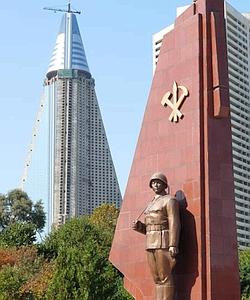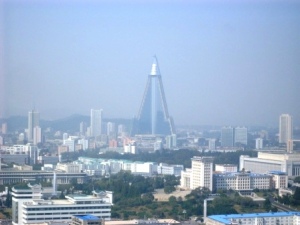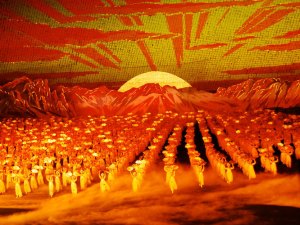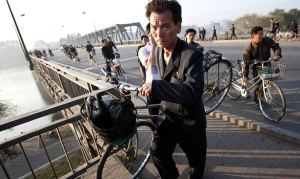(Donald Kirk, The Christian Science Monitor, August 3, 2010) South Korea is sailing into naval exercises in the Yellow Sea on Thursday and Friday to the din of intimidating rhetoric from North Korea and rising fears about China’s response to military drills in waters so close to the Chinese mainland .
Pyongyang’s Korean Central News Agency on Tuesday quoted a military official warning of “powerful physical retaliation” if South Korean ships and planes go through with their latest attempt at enhancing their skills in antisubmarine warfare.
North Korea often issues strong threats without following through, but the latest warning comes from the regime’s western command, which a South Korean investigation blames for the March 26 sinking of its corvette, Cheonan. Experts from the US, Britain, Australia, and Sweden on the investigation team found that a North Korean midget submarine had fired the torpedo that split the vessel in two, sinking it in minutes and causing the deaths of 46 South Korean sailors. North Korea continues to deny having anything to do with the incident.
The statement said that forces in North Korea’s western sector had “made a decisive resolution to counter the reckless naval firing projected by the group of traitors.” The North’s western command coupled that vow with a warning for all shipping, notably the fishing boats that ply the area, to stay away for the duration of the South Korean exercises.
Despite the Cheonan sinking, however, analysts here see the rhetoric as similar to that with which North Korea greeted last week’s joint exercises in waters off South Korea’s east coast on the opposite side of the Korean peninsula, led by the US aircraft carrier George Washington.
Defence Professionals (August 3, 2010) …Begin on July 25, the South Korea-U.S. drill, code-named “Invincible Spirit,” was meant to punish North Korea for the sinking of the Cheonan and warn it against further attacks. KF-16 fighters under South Korean Air Force reveal their strength by neutralizing virtual targets by firing Mk-82 air-to-ground bombs during bombing exercise on the last day of South Korea-U.S. joint drill on July 28.
The drill was the largest ever for the two allies since the end of the Korean War(1950-53), and 20 warships, including the nuclear-powered U.S. aircraft carrier U.S.S. George Washington, 200 aircraft and 8,000 servicemen from two countries were mobilized. In particular, four F-22 Raptor stealth fighters, the most advanced jet fighters in the world, made their debut over Korean skies. The U.S. claims the aircraft can strike the North’s nuclear facility site at Yongbyon within 30 minutes after takeoff.
During the last day of the joint drill, South Korean 4,400-ton destroyers, including Choi Young, Ticonderoga-class Aegis cruiser USS Curtis Wilber and Logistic Support Ship Cheonji engaged in the joint exercise on East Sea. Also both South Korean and U.S. navies jointly took part in a logistics maneuver on waters which logistics support ship and destroyers sail in parallel for a refuel.
Like a day earlier, both navies perform joint anti-submarine exercise such as dropping depth charges and firing torpedoes against simulated targets in order to improve joint military capabilities to cope with possible enemy submarine’s insurgent. In addition, F-15K of South Korean Air Force and F/A-18A/C Hornet and F/A-18E/F Superhornet of U.S. Air Force took part in a joint air drill by performing actual firing and bombing toward exercise field in Gangwon and Gyeonggi provinces.
“It was a great opportunity for Seoul and Washington to develop joint anti-submarine as well as air combat skills during the four-day joint drill period,” said a defense official under the Joint Chiefs of Staff in Seoul. “We were able to reveal powerful South Korea-U.S. joint military strength and sent strong warning toward the North that we will not tolerate further attacks.”
Seoul and Washington are slated to assess the joint drill comprehensively and check faults so that they can reflect on the next joint exercises. As foreign and defense ministers from both countries agreed during their ‘2+2’ talks in Seoul on July 20, both allies are planning to conduct joint anti-submarine naval exercise on East and Yellow Sea for next several months. The South Korean government described Invincible Spirit as a success, saying it sent a clear warning to the North against any future provocations.
North Korea has shown no military reaction during the drill, despite its vow before the drill began to make a “sacred war.”
(Sunny Lee, The National August 04. 2010 ) After the massive joint naval drills last month in the eastern part of the Korean Peninsula with the US, South Korea begins a fresh round of its own war games near the North Korean border.
South Korea is staging this new manoeuvre “because the US did not go far enough with the joint naval exercises last month,” said Gordon Chang, the author of Nuclear Showdown: North Korea Takes On the World. South Korea initially had wanted to hold that exercise in the Yellow Sea, but China objected. The US-South Korea joint drills were then moved. “Beijing intimidated Washington with its warnings to stay out of the Yellow Sea. That, predictably, left Seoul steaming mad, at least in private,” Mr Chang said.
South Korea’s defence ministry said the exercise would involve three submarines, a destroyer, 30 other vessels and 50 aircraft. Some 4,500 troops will be deployed and marines will conduct live-fire exercises. “The drills will be conducted just like they were real,” a South Korean military official told Seoul’s Yonhap news agency. The South’s Navy Rear Admiral Kim Kyung-sik countered the North by saying that if North Korea makes good on its threat to open fire, South Korea “will stage an immediate counter-attack”.
Kim Heung-kyu, an analyst at a state-run think tank in Seoul, said South Korea should be wary. “North Korea has been making efforts to display to the international community that it doesn’t make empty threats,” he said. Analysts see the rationale of South Korea’s current move. “After all, it was an attack on a South Korean warship. So, some measures are necessary,” said Andrei Lankov, an analyst who teaches at Kookmin University in Seoul.
Mr Kim said North Korea’s strategists likely believe that elevated tension benefits the regime. “Raising tensions on the Korean Peninsula will pit the US and China, the two powerful stakeholders in the region, against each other,” he said. South Korea’s liberal media outlets speculated that the US and South Korea’s harsh stance against the North may be an “all-around” pressure tactic to provoke the collapse of North Korea.
“The North Korean situation is very dire now,” said Zhao Huji, a political scientist at the Central Party School in Beijing. Mr Zhao said North Korea is under tremendous difficulty. “It’s true that there are dissenting voices at the senior cadre level in North Korea since the failure of the botched currency reforms last year,” he said. “But adding too much pressure on the whole North Korea at this time without a breather is not going to work. The North leadership will use the outside pressure to consolidate its internal unity.”
Analysts also see what was originally a conflict between the two Koreas as a power game between the US and China. Beijing sees the military drills Washington carried out with South Korea near China’s waters as a convenient ploy for the US to reclaim its power in the region. China on Tuesday began a five-day live-fire exercise in the coastal provinces near the Yellow Sea. Zhao Zongqi, the commander of the drill, told the official China Daily that the exercise is “to make effective preparations for military combat”.
—







 Par Arnaud de la Grange, envoyé spécial à Pyongyang, (Le Figaro 20/10/2009)
Par Arnaud de la Grange, envoyé spécial à Pyongyang, (Le Figaro 20/10/2009)
 by Louisa Lim, NPR, 8 October 2009
by Louisa Lim, NPR, 8 October 2009 by Richard Lloyd Parry (The Times, 06 October 2009)
by Richard Lloyd Parry (The Times, 06 October 2009)
You must be logged in to post a comment.